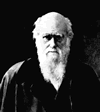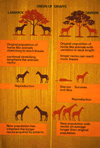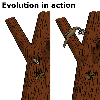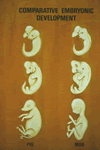Organisms within any one kingdom of living things are further classified into groups showing increasing structural similarity.
|
Phylum Order Family Genus Species |
|
Species
A species is a population of organisms which closely resemble each other
structurally and physiologically, and which can interbreed to produce
live fertile offspring.
They are therefore said to share the same gene pool, because the genes (inherited information) of the different individuals can mix through mating.
In contrast, if a horse and a donkey do breed, the offspring (mule) is sterile and therefore cannot breed itself, so the gene pools of the two different species remain separate.
Mutations
There is variation between all individuals in populations, as is obvious
in the human population. Some of these differences are "acquired"
such as tattoos and spiked hair, and these will not be inherited by the
offspring. For inherited features though, the original source of the variation
is due to changes in the genetic code (called mutations) which occur during
the formation of the gametes (sex cells). These changes are randomly passed
on to offspring leading to variation between individuals. A mutation in
a sperm or ovum changes the genetic information, coding for a different
mutant feature in the resulting offspring. Mutations occur naturally,
but their frequency can be increased by factors such as radiation (e.g.
X rays or nuclear fallout) and certain chemicals.
Mutations and evolution
Some mutations are fatal and the offspring never develop. If, however,
the mutation creates a feature that aids survival (i.e. it is an adaptation),
then that organism is more likely to survive and reproduce successfully,
leaving more offspring which carry that mutation also. If the environment
changes, then different features will be advantageous.
 The British naturalist, Charles Darwin, travelled to South America
in 1835 and his observations led him to suggest that species changed over
time by a process referred to as "evolution". He hypothesised
that this occurred by the process of Natural Selection or "survival
of the fittest".
The British naturalist, Charles Darwin, travelled to South America
in 1835 and his observations led him to suggest that species changed over
time by a process referred to as "evolution". He hypothesised
that this occurred by the process of Natural Selection or "survival
of the fittest".  By
this he meant that there is variation between individuals in a population
and those individuals best adapted in a certain environment will survive
best and pass on those traits to their offspring. Therefore, over the
next generations, the number of well-adapted individuals increases until
most of the population carries the trait.
By
this he meant that there is variation between individuals in a population
and those individuals best adapted in a certain environment will survive
best and pass on those traits to their offspring. Therefore, over the
next generations, the number of well-adapted individuals increases until
most of the population carries the trait.
Speciation
 Two separate species can develop from one ancestral species if the two
groups are isolated over a long period of time, during which the environmental
conditions change and natural selection operates.
Two separate species can develop from one ancestral species if the two
groups are isolated over a long period of time, during which the environmental
conditions change and natural selection operates.
Darwin's theory of evolution through natural selection was in contrast
to the theory of Jean Lamarck (France, early 1800s) which suggested that
organisms could aquire new characteristics during a lifetime and these
could be passed to the next generation, whereas Darwin observed that the
variation already existed in the population.
Case history
 In
Pre-Industrial England, light-coloured pepper moths were common, escaping
predation by birds because of their camouflage against the light-coloured
lichens on the trees. Dark moths were easy prey.
In
Pre-Industrial England, light-coloured pepper moths were common, escaping
predation by birds because of their camouflage against the light-coloured
lichens on the trees. Dark moths were easy prey.
Industrialisation created air pollution and tree-trunks became darkened.
Darker moths seemed to appear and become more numerous. These mutant forms
now had a distinct survival advantage because light-coloured moths were
easily seen on the darker trees and were eaten by birds. The mutant dark
ones survived and had many dark offspring with the result that the population
changed through time. A considerable time later, and with further environmental
change, a new species may well evolve.
 Fossil
evidence
Fossil
evidence
Fossil evidence suggests that life forms have changed significantly from
the very simple organisms found in the earliest fossil layers. Similarities
in embryonic forms and DNA (genetic information) also point to common
ancestry.

| Copyright owned by the State of Victoria (Department of Education and Early Childhood Development). Used with Permission. |